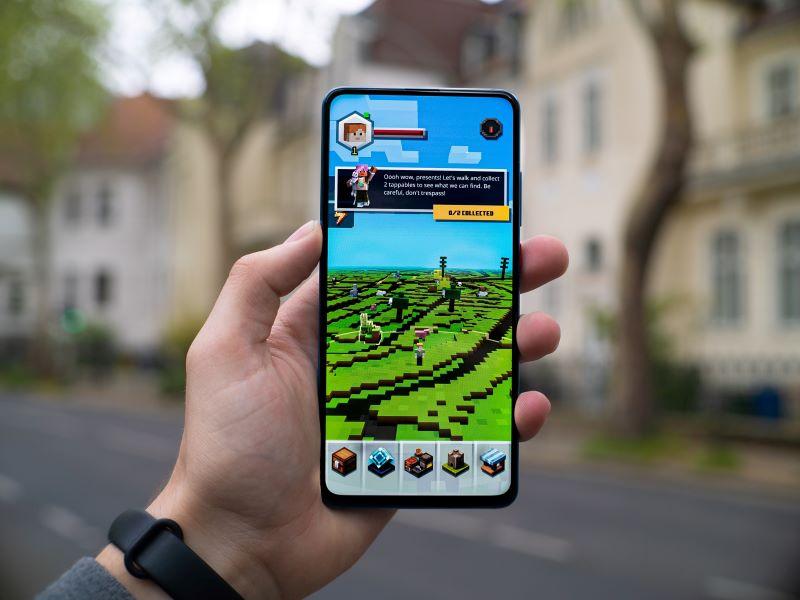
Generating immersive, large-scale teaching experiences in video games
Students learn by doing. They learn when they are engaged. Teaching within video games achieves both these things. Lockdown and the subsequent move to remote learning may have spurred an increase in video game-based learning, but the approach is universally valuable – video games are played by over 40 per cent of the world’s population.
Across many disciplines, collecting data from the field is crucial for the understanding of key methodologies and concepts. But Covid created a barrier to much in-person fieldwork. So to meet the need for remote but practical learning, we designed Project Millport: an immersive fieldwork experience built in Minecraft, one of the the world’s most popular video games and a tremendously customisable virtual world. Our aim was to create a digital environment that faithfully replicated the fieldwork experience for students on our zoology course who would normally spend five days sampling flora and fauna on the beaches of Great Cumbrae.
Here are some of the lessons learned from this and Richard’s outreach work for Neuron Safari, a unique Minecraft world that offers an introductory look into basic neuroscience and cellular concepts using real data.
Do more than is necessary for your learning outcomes
Games are compelling because they offer much more than the main story or core objectives. There are hidden surprises and treasures, open world landscapes to explore, artwork, books, histories and other details that enrich the environment but are not strictly needed. Immersion is about building an experience that becomes your main reality for the duration of the task. In a learning context, if you fill the digital space with curious elements, giving it more layered complexity than the learning task, students will spend more time exploring and become more familiar, comfortable and engaged. This should not be underestimated.
Make a narrative, make a lore, make a history. Give the virtual world life and the space and potential to evolve and grow. Your students should want to spend time within your virtual world and to extend it themselves.
Give students agency and choice
Game-based environments allow for lots of control and constraints on user experiences, and when done right these can greatly enhance learning outcomes and perceptions of the experience. But they need to be flexible and lenient. Allow students to explore, to make mistakes, to get stuck. Give them options, even if the choice in the end makes no difference to the end result. Let each user generate their own path to the same learning outcomes; to how, when, where they collect data, and what that data is. In some cases, planning and design is the learning outcome, so it is crucial to let the students make choices, fumble and try again.
Complement and enhance, do not replace
Do not build with the intention of replacing an existing practice. Think about how your activity will complement other teaching activities, what it can extend and feed into. It may eventually come to replace something but let it do so naturally.
Give yourself the time to plan and build
You can often end up making a game within a game. Respect the time that that will take. Not just in the construction of the experience, but in the conceptualisation, the prototyping, and the discussions with staff and students to ensure the experience is relevant and accessible. You need months, not weeks, regardless of the size of your team.
Make it flexible and accessible
Don’t restrict your build to a specific set of learning outcomes – try to build in adaptability, ways of extending or truncating the activity to fit different needs that may arise over time. Modularisation of elements can help greatly and make it easier to share your activity with others.
Use software designed for gaming
When using a game-based environment, there are plenty of powerful, well tested tools out there to help with modifications, streaming gameplay (Twitch) and communication (Discord). Minecraft, for example, has a wealth of tools to help with modifying the experience, and many people, including user communities numbering thousands, are willing to offer advice or help with construction.
Co-create with students and be inspired by them
Most of my best ideas have come from talking to students, seeing models they have built, and learning from them how to manipulate Minecraft to meet a challenge. Some have played games like Minecraft their entire lives and have a wealth of expertise to draw upon. Work with them and pay them in cash – not course credits – for their time and expertise, as you would for any other professional consultant.
Think big. Think abstract
Sandbox spaces like Minecraft allow users to modify the environment, often without any strictly defined objective. This gives you the opportunity to be bold and build to grand, oversized scales. You can scale things up – make proteins large, bring bacteria to gigantic sizes. You can also go abstract – make stochastic reaction networks out of redstone circuitry or turn protein transport networks into train networks.
You are only really limited by your creativity
I have imported real neuronal structures into Minecraft, let users bungee jump through gigantic ion channels and used student-built DNA factories to teach. I have terraformed a 1:25 scale version of Puerto Rico, used carrot on sticks to measure data from turtles and built working animal behavioural experiments scaled to human use. We use images, hyperlinks, and QR codes; embed custom data in blocks and in-game entities, and can collect data on user choices and exploration paths. Embracing the playfulness and sheer amount of uncertainty involved is crucial and, perhaps more importantly, fun.
Richard Fitzpatrick is a PhD student in the Centre for Discovery Brain Sciences as part of the University of Edinburgh-Zhejiang University partnership. Thomas Little is a professor in evolutionary biology at the University of Edinburgh.
Additional Links
Read more about Richard and Thomas’s work on the University of Edinburgh Teaching Matters blog:
Generating immersive large-scale virtual field work for Zoology students
Projects, peers, passion, and Play: How Minecraft transforms (hybrid) teaching




